|
Hilly Flanks
The Hilly Flanks are the upland areas surrounding the Fertile Crescent of Southwest Asia, including the foothills of the Zagros Mountains, the Taurus Mountains, and the highland parts of the Levant. The Hilly Flanks foothill chain spans over 1000 miles, including parts of Turkey, northwestern Iraq, and western Iran. The region is just north of Mesopotamia, with similar characteristics of fertility with the added trait of foothills and plateaus. The term was coined by Robert Braidwood in 1948. He proposed that the Neolithic Revolution began in the Hilly Flanks because these areas received enough rainfall for agriculture without irrigation. He also observed that many of the wild progenitors of domesticated crops had their natural habitats in the Hilly Flanks, as did wild sheep and goat. His theory was in opposition to the oasis theory of V. Gordon Childe, which placed the origins of agriculture in well-watered desert refugia such as Mesopotamia. Ultimately, archaeological invest ... [...More Info...] [...Related Items...] OR: [Wikipedia] [Google] [Baidu] |
Zagros Mountains
The Zagros Mountains are a mountain range in Iran, northern Iraq, and southeastern Turkey. The mountain range has a total length of . The Zagros range begins in northwestern Iran and roughly follows Iran's western border while covering much of southeastern Turkey and northeastern Iraq. From this border region, the range continues southeast to the waters of the Persian Gulf. It spans the southern parts of the Armenian highlands, and the whole length of the western and southwestern Iranian plateau, ending at the Strait of Hormuz. The highest point is Mount Dena, at . Geology The Zagros fold and thrust belt was mainly formed by the collision of two tectonic plates, the Eurasian Plate and the Arabian Plate. This collision mainly happened during the Miocene (about 25–5 mya or million years ago) and folded the entirety of the rocks that had been deposited from the Paleozoic (541–242 mya) to the Cenozoic (66 mya – present) in the passive continental margin on the Ar ... [...More Info...] [...Related Items...] OR: [Wikipedia] [Google] [Baidu] |
Wild Goat
The wild goat (''Capra aegagrus'') is a wild goat species, inhabiting forests, shrublands and rocky areas ranging from Turkey and the Caucasus in the west to Turkmenistan, Afghanistan and Pakistan in the east. It has been listed as near threatened on the IUCN Red List and is threatened by destruction and degradation of habitat. It is thought to be the ancestor of the domestic goat (''C. hircus''). Taxonomy ''Capra aegagrus'' was the first scientific name proposed by Johann Christian Polycarp Erxleben in 1777 for the wild goat populations of the Caucasus and Taurus Mountains. ''Capra blythi'' (proposed by Allan Octavian Hume in 1874) was given to wild goat horns found from Sindh. Both the Bezoar ibex (''C. a. aegagrus)'' and the Sindh ibex (''C. a. blythi)'' are considered to be valid subspecies of the wild goat. There is debate as to whether or not the Chiltan ibex (''C. a. chialtanensis).'' Though it was initially thought to be a distinct subspecies, it is now considere ... [...More Info...] [...Related Items...] OR: [Wikipedia] [Google] [Baidu] |
Oases
In ecology, an oasis (; : oases ) is a fertile area of a desert or semi-desert environmentBattesti, Vincent (2005) Jardins au désert: Évolution des pratiques et savoirs oasiens: Jérid tunisien. Paris: IRD éditions. . that sustains plant life and provides habitat for animals. Surface water may be present, or water may only be accessible from wells or underground channels created by humans. In geography, an oasis may be a current or past rest stop on a transportation route, or less-than-verdant location that nonetheless provides access to underground water through deep wells created and maintained by humans. Although they depend on a natural condition, such as the presence of water that may be stored in reservoirs and us ... [...More Info...] [...Related Items...] OR: [Wikipedia] [Google] [Baidu] |
Desiccation
Desiccation is the state of extreme dryness, or the process of extreme drying. A desiccant is a hygroscopic (attracts and holds water) substance that induces or sustains such a state in its local vicinity in a moderately sealed container. The word desiccation comes . Industry Desiccation is widely employed in the oil and gas industry. These materials are obtained in a hydrated state, but the water content leads to corrosion or is incompatible with downstream processing. Removal of water is achieved by cryogenics, cryogenic condensation, absorption into glycols, and absorption onto desiccants such as silica gel. Laboratory A desiccator is a heavy glass or plastic container, now somewhat antiquated, used in practical chemistry for drying or keeping small amounts of materials very dry. The material is placed on a shelf, and a drying agent or ''desiccant'', such as dry silica gel or anhydrous sodium hydroxide, is placed below the shelf. Often some sort of humidity indicator is ... [...More Info...] [...Related Items...] OR: [Wikipedia] [Google] [Baidu] |
Near East
The Near East () is a transcontinental region around the Eastern Mediterranean encompassing the historical Fertile Crescent, the Levant, Anatolia, Egypt, Mesopotamia, and coastal areas of the Arabian Peninsula. The term was invented in the 20th century by modern Western geographers and was originally applied to the Ottoman Empire, but today has varying definitions within different academic circles. The term ''Near East'' was used in conjunction with the ''Middle East'' and the ''Far East'' (China and beyond), together known as the "three Easts"; it was a separate term from the ''Middle East'' during earlier times and official British usage. As of 2024, both terms are used interchangeably by politicians and news reporters to refer to the same region. ''Near East'' and ''Middle East'' are both Eurocentrism, Eurocentric terms. According to the National Geographic Society, the terms ''Near East'' and ''Middle East'' denote the same territories and are "generally accepted as comprisin ... [...More Info...] [...Related Items...] OR: [Wikipedia] [Google] [Baidu] |
North Africa
North Africa (sometimes Northern Africa) is a region encompassing the northern portion of the African continent. There is no singularly accepted scope for the region. However, it is sometimes defined as stretching from the Atlantic shores of the Western Sahara in the west, to Egypt and Sudan's Red Sea coast in the east. The most common definition for the region's boundaries includes Algeria, Egypt, Libya, Morocco, Tunisia, and Western Sahara, the territory territorial dispute, disputed between Morocco and the list of states with limited recognition, partially recognized Sahrawi Arab Democratic Republic. The United Nations’ definition includes all these countries as well as Sudan. The African Union defines the region similarly, only differing from the UN in excluding the Sudan and including Mauritania. The Sahel, south of the Sahara, Sahara Desert, can be considered as the southern boundary of North Africa. North Africa includes the Spanish cities of Ceuta and Melilla, and the ... [...More Info...] [...Related Items...] OR: [Wikipedia] [Google] [Baidu] |
Livestock
Livestock are the Domestication, domesticated animals that are raised in an Agriculture, agricultural setting to provide labour and produce diversified products for consumption such as meat, Egg as food, eggs, milk, fur, leather, and wool. The term is sometimes used to refer solely to animals which are raised for consumption, and sometimes used to refer solely to farmed ruminants, such as cattle, sheep, and goats. The breeding, maintenance, slaughter and general subjugation of livestock called ''animal husbandry'', is a part of modern agriculture and has been practiced in many cultures since humanity's transition to farming from hunter-gatherer lifestyles. Animal husbandry practices have varied widely across cultures and periods. It continues to play a major economic and cultural role in numerous communities. Livestock farming practices have largely shifted to intensive animal farming. Intensive animal farming increases the yield of the various commercial outputs, but also nega ... [...More Info...] [...Related Items...] OR: [Wikipedia] [Google] [Baidu] |
Agriculture
Agriculture encompasses crop and livestock production, aquaculture, and forestry for food and non-food products. Agriculture was a key factor in the rise of sedentary human civilization, whereby farming of domesticated species created food surpluses that enabled people to live in the cities. While humans started gathering grains at least 105,000 years ago, nascent farmers only began planting them around 11,500 years ago. Sheep, goats, pigs, and cattle were domesticated around 10,000 years ago. Plants were independently cultivated in at least 11 regions of the world. In the 20th century, industrial agriculture based on large-scale monocultures came to dominate agricultural output. , small farms produce about one-third of the world's food, but large farms are prevalent. The largest 1% of farms in the world are greater than and operate more than 70% of the world's farmland. Nearly 40% of agricultural land is found on farms larger than . However, five of every six farm ... [...More Info...] [...Related Items...] OR: [Wikipedia] [Google] [Baidu] |
Interdisciplinary Research
Interdisciplinarity or interdisciplinary studies involves the combination of multiple academic disciplines into one activity (e.g., a research project). It draws knowledge from several fields such as sociology, anthropology, psychology, economics, etc. It is related to an '' interdiscipline'' or an ''interdisciplinary field,'' which is an organizational unit that crosses traditional boundaries between academic disciplines or schools of thought, as new needs and professions emerge. Large engineering teams are usually interdisciplinary, as a power station or mobile phone or other project requires the melding of several specialties. However, the term "interdisciplinary" is sometimes confined to academic settings. The term ''interdisciplinary'' is applied within education and training pedagogies to describe studies that use methods and insights of several established disciplines or traditional fields of study. Interdisciplinarity involves researchers, students, and teachers in the ... [...More Info...] [...Related Items...] OR: [Wikipedia] [Google] [Baidu] |
Archaeologist
Archaeology or archeology is the study of human activity through the recovery and analysis of material culture. The archaeological record consists of Artifact (archaeology), artifacts, architecture, biofact (archaeology), biofacts or ecofacts, archaeological site, sites, and cultural landscapes. Archaeology can be considered both a social science and a branch of the humanities. It is usually considered an independent academic discipline, but may also be classified as part of anthropology (in North America – the four-field approach), history or geography. The discipline involves Survey (archaeology), surveying, Archaeological excavation, excavation, and eventually Post excavation, analysis of data collected, to learn more about the past. In broad scope, archaeology relies on cross-disciplinary research. Archaeologists study human prehistory and history, from the development of the first stone tools at Lomekwi in East Africa 3.3 million years ago up until recent decades. A ... [...More Info...] [...Related Items...] OR: [Wikipedia] [Google] [Baidu] |
Robert John Braidwood
Robert John Braidwood (29 July 1907 – 15 January 2003) was an American archaeologist and anthropologist, one of the founders of scientific archaeology, and a leader in the field of Near Eastern Prehistory. Life Braidwood was born July 29, 1907, in Detroit, Michigan, the first child of Walter John Braidwood (ca. 1876) and Reay Nimmo (1881), and was educated at the University of Michigan, from where he graduated with an M.A. in architecture in 1933. Within a year he had joined the University of Chicago Oriental Institute's expedition to the Amuq Plain with the archaeologist James Henry Breasted. He worked with the expedition until 1938, during which time he married fellow Michigan graduate Linda Schreiber, who became his partner in the field and in his research. Braidwood spent World War II working for the Army Air Corps, in charge of a meteorological mapping program. In 1943 he gained his Ph.D. from the University of Chicago, who immediately employed him, and at whose ... [...More Info...] [...Related Items...] OR: [Wikipedia] [Google] [Baidu] |
Neolithic
The Neolithic or New Stone Age (from Ancient Greek, Greek 'new' and 'stone') is an archaeological period, the final division of the Stone Age in Mesopotamia, Asia, Europe and Africa (c. 10,000 BCE to c. 2,000 BCE). It saw the Neolithic Revolution, a wide-ranging set of developments that appear to have arisen independently in several parts of the world. This "Neolithic package" included the History of agriculture, introduction of farming, domestication of animals, and change from a hunter-gatherer lifestyle to one of sedentism, settlement. The term 'Neolithic' was coined by John Lubbock, 1st Baron Avebury, Sir John Lubbock in 1865 as a refinement of the three-age system. The Neolithic began about 12,000 years ago, when farming appeared in the Epipalaeolithic Near East and Mesopotamia, and later in other parts of the world. It lasted in the Near East until the transitional period of the Chalcolithic (Copper Age) from about 6,500 years ago (4500 BCE), marked by the development ... [...More Info...] [...Related Items...] OR: [Wikipedia] [Google] [Baidu] |






